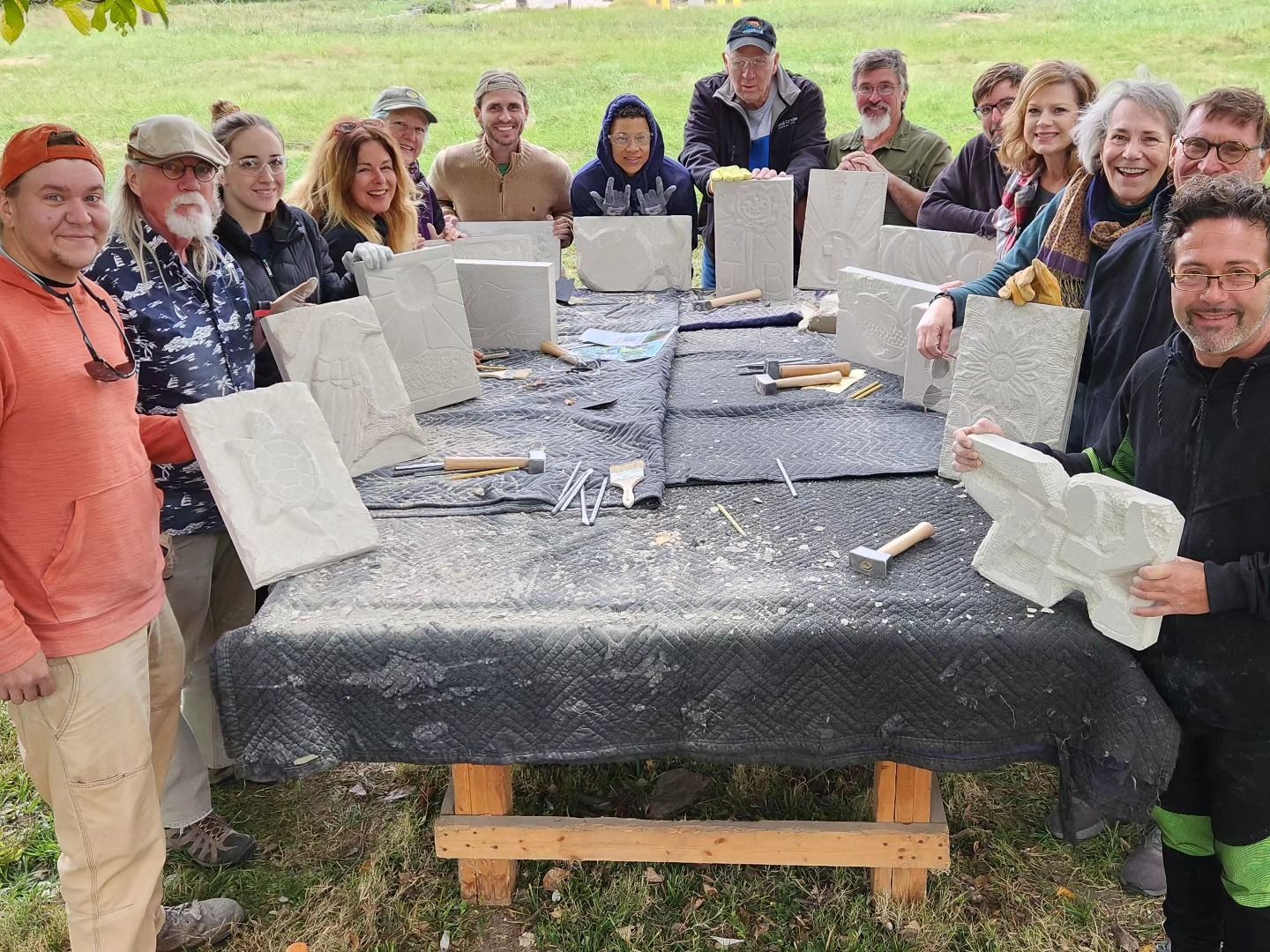
Notes on a stone carving workshop.
By Origin Guest Writer Bob Hill

The general idea was to transform a thin slice of 340-million-year-old Hoosier limestone into chiseled art in about six hours.
The location was Southern Indiana’s Origin Park, a delicious, 430-acres of welcoming woods, trails, fields, ponds and Ohio River shoreline to soon include a River Arts House, Events Center and Event Lawn. One of Origin Park’s goals is to showcase local artists.
The 14 participants, whose abilities ranged from artistic to, well, enthusiastic, stood over four tables, special hammers and chisels in hands. Staring back up at them were flat, 10-by-16-inch slabs of gray limestone. Let the chiseling begin. There is a music that comes with 14 people taking steel hammers to metal chisels. A frantic, ringing “clink, clink, clink” heard hundreds of times a minute. Most participants by then had an idea of what they wanted to appear in that flat limestone, some of it mirroring the ancient watery past that had created that very limestone, fish, turtles and huge birds. Other works were religious, or abstract. The tools were fun, small, almost dainty hammers carefully crafted to bang on a variety of chisels, each with a specific purpose. Hammer out the first lines, widen and shape them, then chip away at the edges. The hope was to chisel away just enough of the right limestone to have the creatures rise above the rock. Small chips and limestone dust literally flew in gusts of wind.
What made our venture even more interesting was just 50 yards away, in a grassy field overlooking the river, archaeologists have recently been digging up evidence of the people who lived on this very spot thousands of years ago, a people who used similar-looking hand tools, mortar and pestle, to survive. Our six hours of work came over two days. Our leader was Joe Autry, a Hoosier artist whose work has included bronze, stone, the chainsaw-transformation of dead trees into living art, and several trips to Russia, Germany, Japan and Latvia to sculpt ice at minus 20 degrees.
There is a certain similarity between staring at a blank computer screen wondering what words might show up and staring at an empty piece of limestone: What’s next? Autry provided some cardboard cut-outs of turtles and fish that could first be traced on stone by pencil, but the work was all in our hands. His quiet, low-key manner, and his incredible creation of a large snapping turtle from a large block of empty limestone, was the perfect leadership needed. He offered encouragement where needed, suggested patience when necessary. You can’t rush 340-million-year-old limestone.
My creation – even Rodin had to begin somewhere - was an alleged sunny sunflower that Autry quickly repaired into a smiling rose. My sculpture tablemate, attorney David Lewis, also a first-timer at this, created an amazingly complex floral pattern that included a delicate bumblebee. It was a heads down, get to work bunch. Our constant background remained that “clink, clink, clink” of hammer-to-chisel soon punctuated by conversation, then laughter, as once strangers quickly bonded over the tasks at hand. We would occasionally pause from our work to wander the other tables, seeing what others were up to, comparing the results, offering sincere compliments, or mostly polite words where an alleged smiling sunflower was concerned. If you listened to the clinking carefully enough, the sound changed with the hours. The first day, as the first lines were created, the music was louder, more insistent. On the final day, as the work grew more focused, the extra limestone hammered away, the music had a different deeper tone. The final strokes, the cleanup between the lines, was more delicate, the coda if you will. A truly fun experience. Every member of this orchestra went home happy.


